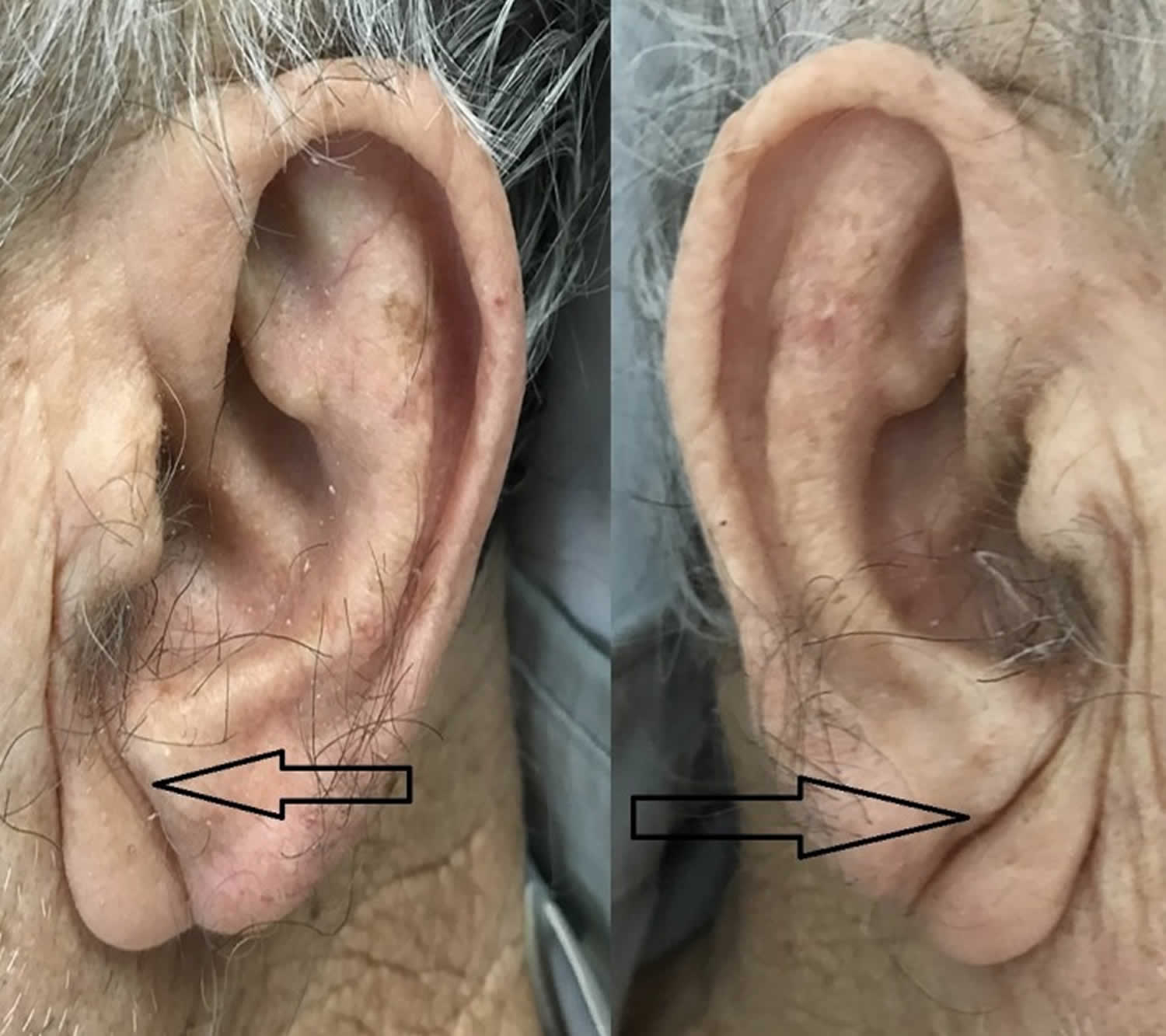Frank’s sign
Frank’s sign is presence of bilateral diagonal earlobe creases 1. Frank’s sign has been traditionally considered as a surrogate marker of coronary and carotid artery atherosclerosis 2. It was first associated with coronary artery disease in an article by Sanders T. Frank published in 1973 3. Alternative hypotheses such as coincident association between aging changes and atherosclerosis, anatomic peculiarity, or a result of a particular way of sleeping have also been proposed for diagonal ear lobe creases 4. However, its exact etiology remains unknown, and its association with cardiovascular diseases has been questionable 1. Although controversies remain, a recent study by Shmilovich et al. found that it is associated not only with the presence of coronary atherosclerosis but also with its extent and severity 5. It has been postulated that ear lobe and myocardium are supplied by the same genetically originated end arterioles and thus share a common pathway 6.
An unbalanced collagen-elastin ratio in the earlobe vasculature and coronary beds is common in patients with Frank’s sign diagonal earlobe creases 1. Shortened chromosomal telomeres found in male patients support the relationship between accelerated skin aging and accelerated atherosclerosis (i.e., coronary aging). However, the exact mechanism of Frank’s sign in relation to the extent, severity, and prevalence of atherosclerosis is unknown and warrants further exploration 7. Whether Frank’s sign diagonal earlobe creases is a predictor of underlying coronary artery disease, stroke, and peripheral vascular diseases or merely a trivial sign of aging process is still unclear. The length, depth, bilateralism, and inclination of frank’s sign diagonal earlobe creases seem to relate to cardiovascular events 8.
While a few previous studies suggest that there is no relationship between Frank’s sign diagonal earlobe creases and cardiovascular disease, many recent studies report that Frank’s sign diagonal earlobe creases is an independent predictor of heart diseases regardless of other cardiac risk factors such as hypertension, diabetes, obesity, cholesterol, blood pressure, or smoking. Frank’s sign diagonal earlobe creases may also correlate with a myriad of other diseases such as cerebrovascular diseases, carotid stenosis, and peripheral vascular diseases in addition to cardiovascular diseases 9. Autopsy findings of patients with Frank’s sign diagonal earlobe creases further support the association of Frank’s sign to cardiovascular diseases 10. Therefore, patients with Frank’s sign should undergo further cardiovascular evaluation 1.
Figure 1. Frank’s sign earlobe
References- Lin AN, Lin K, Kyaw H, Abboud J. A Myth Still Needs to be Clarified: A Case Report of the Frank’s Sign. Cureus. 2018;10(1):e2080. Published 2018 Jan 17. doi:10.7759/cureus.2080 https://www.ncbi.nlm.nih.gov/pmc/articles/PMC5856409
- Friedlander AH, López-López J, Velasco-Ortega E. Diagonal ear lobe crease and atherosclerosis: A review of the medical literature and dental implications. Med Oral Patol Oral Cir Bucal. 2012;17(1):e153–9.
- Frank ST. Aural sign of coronary-artery disease. N Engl J Med. 1973 Aug 9;289(6):327-8. DOI:10.1056/nejm197308092890622
- Gutiu IA, Galeţescu E, Gutiu LI, Răducu L. Diagonal earlobe crease: A coronary risk factor, a genetic marker of coronary heart disease, or a mere wrinkle. Ancient Greco-Roman evidence. Rom J Intern Med. 1996;34(3–4):271–8.
- Shmilovich H, Cheng VY, Rajani R, Dey D, Tamarappoo BK, Nakazato R, et al. Relation of diagonal ear lobe crease to the presence, extent, and severity of coronary artery disease determined by coronary computed tomography angiography. Am J Cardiol. 2012;109(9):1283–7.
- Evrengül H, Dursunoğlu D, Kaftan A, Zoghi M, Tanriverdi H, Zungur M, et al. Bilateral diagonal earlobe crease and coronary artery disease: A significant association. Dermatol Basel Switz. 2004;209(4):271–5.
- Frank’s sign–a dermatological link to coronary artery. Lee K-G. Med J Malaysia. 2017;72:195–196. http://www.e-mjm.org/2017/v72n3/franks-sign.pdf
- Relation of the bilateral earlobe crease to endothelial dysfunction. Oda N, Maruhashi T, Kishimoto S, et al. Am J Cardiol. 2017;119:1983–1988.
- Relationship between diagonal earlobe creases and coronary artery disease as determined via angiography. Wang Y, Mao LH, Jia EZ, et al. BMJ Open. 2016;6:8558.
- Patel V, Champ C, Andrews PS, Gostelow BE, Gunasekara NP, Davidson AR. Diagonal earlobe creases and atheromatous disease: a postmortem study. J R Coll Physicians Lond. 1992;26(3):274–277. https://www.ncbi.nlm.nih.gov/pmc/articles/PMC5375484/pdf/jrcollphyslond90357-0026.pdf






